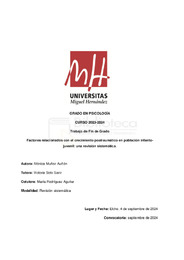Abstract:
El PTG está relacionado como uno de los síntomas positivos del TEPT y se define como un proceso por el cual la persona que ha experimentado una adversidad, situación estresante o desafiante, es decir, una experiencia traumática, obtiene una serie de resultados positivos y aprendizajes favorables para su crecimiento personal. El objetivo del presente estudio es identificar y analizar los factores relacionados con el crecimiento postraumático asociados con el trastorno de estrés postraumático en población infanto-juvenil menor a 18 años. Los estudios fueron seleccionados desde las bases de datos de PubMed, Ovid Medline, PsycArticle y Scopus; siendo 10 artículos incluidos en los resultados finales de la presente revisión. Se identificaron 3 tipos de factores: factores individuales, en los que se incluyen las variables de esperanza y autoeficacia, las diferencias individuales, la salud mental y el sexo, género y edad; factores familiares y sociales, tales como la presencia de hermanos, el nivel socioeconómico, el tipo de parentalidad y las relaciones sociales; y, factores externos, cuyas variables incluyen la gravedad y tipo de evento traumático, el distanciamiento temporal, la cultura y el contexto. En definitiva, el crecimiento postraumático es un proceso multifactorial y que se ha de entender como tal sin dejar de prestar atención a las necesidades y peculiaridades de cada persona y cada situación experimentada.
PTG is related to one of the positive symptoms of PTSD and is defined as a process by which a person who has experienced adversity, a stressful or challenging situation, that is, a traumatic experience, obtains a series of positive results and favorable learning for their personal growth. The objective of the present study is to identify and analyze the factors related to post-traumatic growth associated with post-traumatic stress disorder in children and adolescents under 18 years of age. The studies were selected from the PubMed, Ovid Medline, PsycArticle and Scopus databases; 10 articles were included in the final results of the present review. Three types of factors were identified: individual factors, which include the variables of hope and self-efficacy, individual differences, mental health and sex, gender and age; family and social factors, such as the presence of siblings, socioeconomic level, type of parenting and social relationships; and external factors, whose variables include the severity and type of traumatic event, temporal distancing, culture and context. In short, post-traumatic growth is a multifactorial process and must be understood as such without neglecting to pay attention to the needs and peculiarities of each person and each situation experienced.
|
.png)

